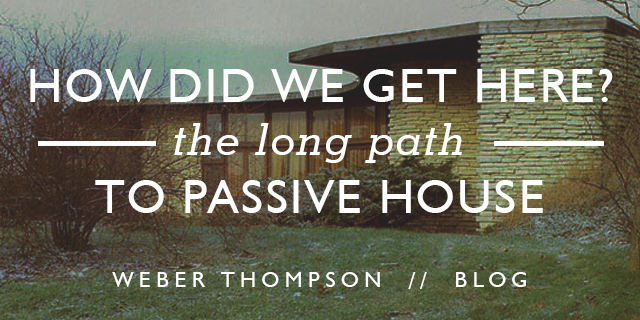By Aaron Swain
Senior Associate, Aaron Swain was project manager during design of Solis, Weber Thompson’s Certified Passive House project in Seattle’s Capitol Hill neighborhood. He is currently the Senior Project Architect on 616 Battery, a 45-story high rise in the Denny Triangle neighborhood.
Last month, the DJC published my article discussing Passive House certification and the design implications in multi-family construction. I used Weber Thompson’s 1300 Pike project in Capitol Hill as a case study. But to better understand the goal of this shift toward Passive House, allow me to pontificate further, with a look at the history of sustainability efforts and how we got to where we are today.
In the pre-industrial world, sustainability was a matter of fact. The pace of life was slower, electricity was not readily available, and much work was done outdoors (warring, farming, smithing and metalurgy, etc.). As our understanding of the natural world improved, we found ways to elude death, increasing the global population, localized in towns and cities. As the population grew, so did the demand for food, goods, and work. This led to competition and the need for more efficient ways to produce food and goods. Work moved indoors, to more controlled environments. Initially, windows and candles provided the light, and stone walls created fairly steady (albeit chilly) temperatures year round.
Enter electricity, the crack-like stimulator of the modern era. It improved our ability to work indoors, powering lights and machines, leading to the industrial invention of the conveyor belt. Electricity eventually spread to our homes to power lights and appliances. As demand grew, so did production, and—with the prevalent use of low-grade fossil fuels—so did pollution.
Never fear! With the invention of the steam and combustion engines, we saw machination go mobile, first with trains, then automobiles. With increased transportation, our cities were able to grow out, allowing people to live away from the pollution-rich factories and industrial zones, travelling to those areas only when necessary for work.
Jump forward to World War II, where we relinquished our ability to elude death on a grand scale, and revealed the darker side of our technological advancements: the ability to kill on a grand scale, literally wiping cities out of existence. This destruction not only took lives, but it also reduced our stock in buildings, stimulating a building boom when all the surviving soldiers returned home.
Perhaps out of fear of the destructive power of energy, perhaps because our power grid was still young and developing, this building boom sometimes embraced the passive strategies of our traditional buildings. Buckminster Fuller’s geodesic domes and Dymaxion House of the 40s took sustainability to a pre-fab culture. Meanwhile, in the 1950s, Frank Lloyd Wright’s Jacob’s House II outside Madison, WI relied on passive strategies out of necessity: many rural areas were still not connected to the grid, or couldn’t afford the monthly bill for a fully-electrified home.
In 1973 with the first fuel embargo and the quadrupling of fuel costs, we were made immediately aware of our dependence on electricity, and fossil fuels as the main source of electricity generation. In response, we again see a resurgence of Passive design strategies being quickly implemented, predominantly in single-family residential developments. Test case prototypes like the Earthships outside Taos, NM showed the potential to reduce our dependence on fossil fuels, as well as a need to focus efforts on localized opportunities. Taking this concept to the city, architects such as Peter Calthorpe and Sim Van der Ryn looked at the larger scale, and the sustainability of density, establishing the “New Urbanist” movement.
In the 80s, this trend toward cities and density grew, with more attention on large-scale projects, such as high-rises and master-planned communities. With these larger buildings also came an attempt to implement some passive strategies—ribbon windows for daylight; better air sealing to reduce envelope losses of heating/cooling, and (to a lesser extent) incorporation of solar power harvesting systems. Unfortunately, the technology had advanced too rapidly, often being instituted in products before they were fully tested or completely understood. Chemical additives that reduced product costs and improved durability, also released toxins over time, now cited as a major cause of the “Sick Building Syndrome” epidemic that plagued the 80s. The quick solution was to revert to “leaky” buildings, which resulted in more energy-intensive buildings. It is also in this decade that the hole in the ozone is “discovered”. Compounded by the space shuttle explosions and cold war ideas like “Star Wars”, we again see fear—this time fear of space and the power of “natural” destruction—forcing us to reassess how we do things.
Beginning in the 90s with the first earth summit in Rio de Janeiro, the global impacts of our day-to-day practices are put under the microscope. The resulting statistic is one we have grown familiar with: buildings consume 40% of the world’s total energy usage, consequently producing the equivalent percentage of the world’s greenhouse gases. This analysis wasn’t just focused on our energy resources: water quality and consumption, air quality, resource harvesting, and waste practices were all looked at more critically and with a demand for greater efficiency. Industry efforts encouraged development teams to look at solutions to ALL these environmental issues, with an equal eye applied across the board, with Certifications like Built Green, and the USGBC’s LEED rating system quickly finding support and popularity, often providing economic value to the owner.
This proved an excellent way to re-start the sustainable conversation, leading to the successful adoption of many sustainable alternatives as common practice. Low-flow bathroom fixtures to reduce water usage; first CFLs, now LEDs to reduce energy needs for lighting; increased attention to the building envelope for thermal, moisture, wind, and solar protection.
Lots of lessons were learned—perhaps most importantly, what works in one location may not work in another. Regulatory jurisdictions began incorporating components and prescriptive strategies in their local codes to require and sometimes incentivize these higher performance design solutions, particularly where resources in the area are scarce for that purpose. California, for example, has pushed for the strictest air quality requirements, with many jurisdictions and even sustainable certifiers relying on the stringent requirements they’ve established. Washington and the City of Seattle have been focused on energy usage, with one of the strictest energy codes in the nation.
With broad acceptance and enforcement of these environmental-related factors, the first need toward a solution to the climate crisis has been largely resolved: broad recognition that there is a problem, and the political will to enforce development toward a solution. It’s been a bumpy road—and there will be many more bumps as we continue down this path, but the path is becoming more clear and attainable.

